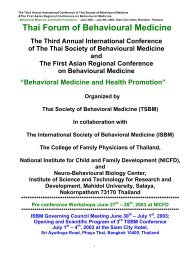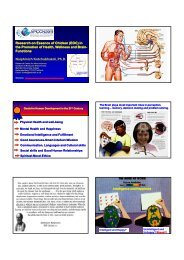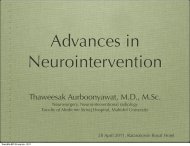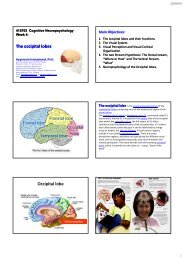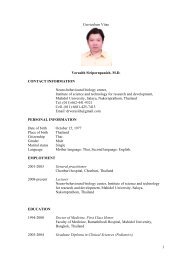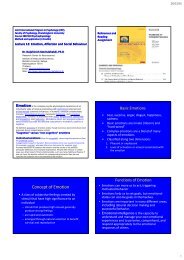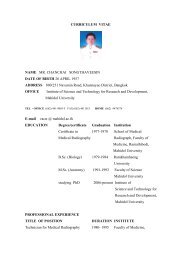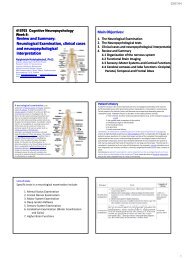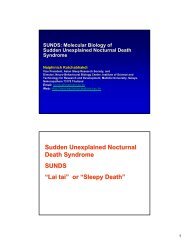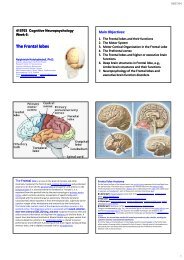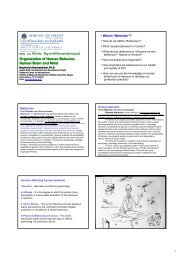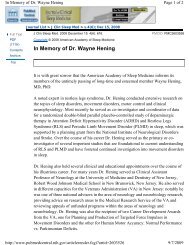PDF File - Mahidol University
PDF File - Mahidol University
PDF File - Mahidol University
You also want an ePaper? Increase the reach of your titles
YUMPU automatically turns print PDFs into web optimized ePapers that Google loves.
384<br />
Abstracts<br />
Quality of life (QoL) is more and more considered an<br />
important indicator of the impact of medical treatment.<br />
With respect to epilepsy surgery in childhood, success of<br />
the operation is measured not only at the level of impairments<br />
(ICIDH 2000), but the child and his parents are also<br />
asked to evaluate postoperative changes in the child’s functioning<br />
in respect of participation. Quality of life, therefore,<br />
is a multidimensional construct that can hardly be understood<br />
solely by quantitative research (van Zuuren, 1999;<br />
Wallander, 2001). Objective: To identify the effects of<br />
epilepsy-surgery on QoL of children suffering from intractable<br />
epilepsy. Design: explorative, pre-post surgery,<br />
prospective, partly qualitative and partly quantitative<br />
research. Methods: ‘HAY’ (how are you) (Bruil, 1999), a<br />
Dutch health-related QoL-questionnaire with a generic and<br />
an epilepsy-specific part, for children between the ages of 7<br />
and 13 years. CBSK (Veerman, 1997), a Dutch adaptation<br />
of the Self-Perception Profile for children between the ages<br />
of 7 and 13 years (Harter, 1985). An open interview was<br />
held with nine children and their parent(s) to obtain an<br />
unrestrained idea of QoL before and after epilepsy surgery.<br />
The qualitative data have been analysed quantitatively.<br />
Results: Both parental and children’s perceptions changed<br />
on all subscales of the HAY. Children report positive<br />
changes in physical and cognitive activities and in feelings<br />
about these activities. Parents report that the children have<br />
become more active in social, physical and cognitive fields<br />
and more proficient in physical activities. Both parents and<br />
children report that, postoperatively, the frequencies of<br />
seizures and of treatment contacts have significantly<br />
decreased. On the CBSK the amelioration on the sub-scale<br />
‘physical appearance’ is significant (P , 0:05) and the<br />
amelioration on the sub-scales Social Acceptance,<br />
Romance, Global Self-worth and Friendship tend to significance<br />
(P , 0:1). The interview data amplify the questionnaire<br />
findings: post-operatively, the child initiates contacts<br />
with peers, the seizure-related necessity of intense one-toone<br />
accompaniment has disappeared, freedom to undertake<br />
social activities has increased accordingly, and – but not<br />
least – the child’s energy has increased. Conclusion: Both<br />
parents and children report a significant improvement in<br />
frequency of social activities, the self-perceptions of the<br />
children improve, some to a statistically significant degree,<br />
and the parents report a significant energy gain.<br />
WS-2-6<br />
Memory impairment in specific childhood epilepsy<br />
syndromes<br />
A.M. Nolan, A. Redoblado, S. Lah, M. Sabaz, J.A. Lawson,<br />
A.M. Cunningham, A. Bleasel, A.M.E. Bye<br />
Department of Neurology, Sydney Children’s Hospital and<br />
The Children’s Hospital; The Universities of New South<br />
Wales and Sydney, Sydney, Australia<br />
Aim: Memory impairment in children with epilepsy can<br />
be a severe disability. Its incidence according to specific<br />
childhood epilepsy syndromes is not well studied. We evaluated<br />
verbal and visual memory in generalised idiopathic<br />
epilepsy (GIE), frontal lobe epilepsy (FLE), temporal lobe<br />
epilepsy (TLE), central epilepsy (CE) and non-localised<br />
partial epilepsy (PE). Methods: From a population of 130<br />
children with epilepsy aged 6–18 years monitored with<br />
video-EEG telemetry, 107 were identified with GIE<br />
(n ¼ 16), FLE (n ¼ 25), TLE (n ¼ 34), CE (n ¼ 12) or<br />
PE (n ¼ 20). Syndrome identification was determined by<br />
International League Against Epilepsy criteria using clinical<br />
data, seizure semiology, interictal and ictal recordings. Each<br />
child had detailed memory evaluation using age-normed<br />
instruments. Memory impairment was defined as scores<br />
more than two standard deviations below the normed<br />
mean. Results: Memory impairment was found in 5% of<br />
GIE and CE, 8% of FLE, 18% of TLE and 20% of PE<br />
children. Four verbal and one visual subtest showed statistically<br />
significant differences in performance between<br />
syndrome groups. GIE had significantly better performance<br />
than TLE in two verbal and the visual subtest (P ¼ 0:019,<br />
P ¼ 0:024, P ¼ 0:055). In one verbal and the visual subtest<br />
GIE had significantly better performance than PE<br />
(P ¼ 0:011, P ¼ 0:019). A trend for better performance in<br />
FLE than TLE approached significance on one verbal subset<br />
(P ¼ 0:052). Discussion: In childhood epilepsy, memory<br />
impairment is a quantifiable problem. Children with GIE<br />
perform best, and significantly worse memory function<br />
can be demonstrated in TLE and PE compared to GIE.<br />
This information is invaluable in planning educational and<br />
therapeutic interventions.<br />
WS-2-7<br />
Genetic abnormalities underlying severe myoclonic<br />
epilepsy in infancy in Japanese<br />
G. Fukuma, S. Hirose, T. Inoue, S. Yasumoto, M. Ohfu, A.<br />
Watanachai, A. Mitsudome, Study Group on Epilepsy<br />
Genetics in Japan<br />
School of Medicine, Fukuoka <strong>University</strong>, Fukuoka, Japan<br />
Objective: To identify genetic abnormalities underlying<br />
SMEI in Japanese. Background: Recently, mutations of the<br />
neuronal voltage-gated Na 1 channel 1 subunit gene<br />
(SCN1A) have been identified as a cause of SMEI.<br />
SCN1A and genes encoding other components of Na 1 channels<br />
in the brain such as 2, one and two subunits (SCN2A,<br />
SCN1B and SCN2B, respectively) were candidate genes for<br />
SMEI. Methods: Our study recruited 54 unrelated individuals<br />
whose clinical manifestations were consistent with<br />
SMEI and 96 healthy volunteers. Each participant or a<br />
responsible person signed an informed consent form<br />
approved by the Ethics Review Committee of Fukuoka<br />
<strong>University</strong> or similar committees of the participating institutions.<br />
Genetic abnormalities of SCN1A, SCN2A, SCN1B<br />
and SCN2B were sought in genomic DNA using a direct



